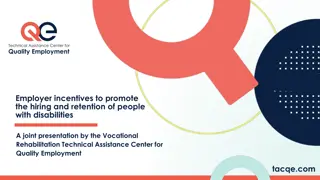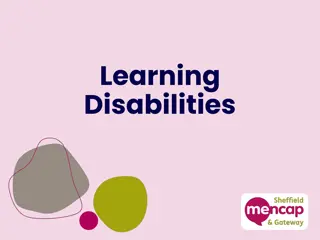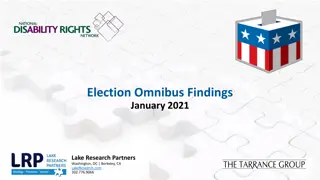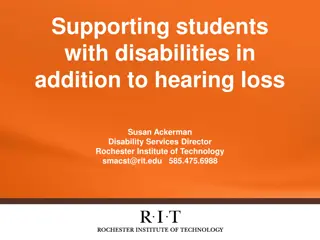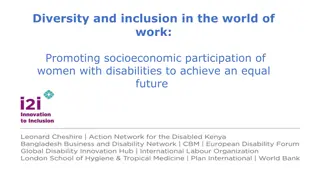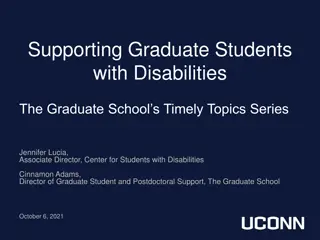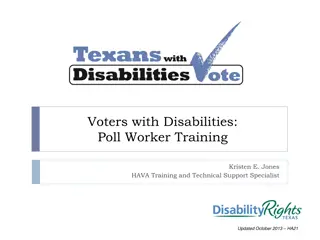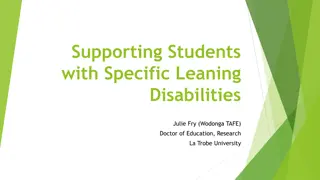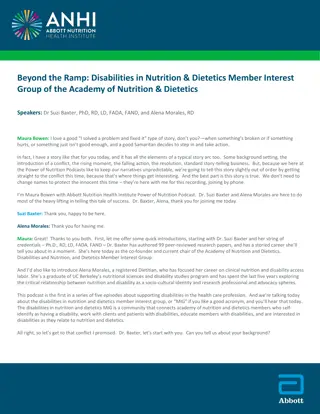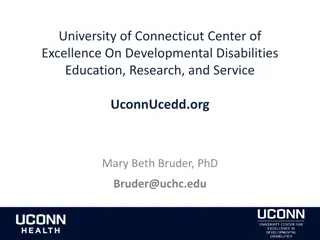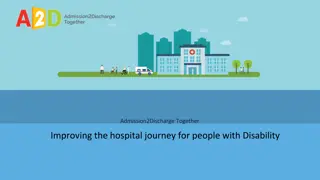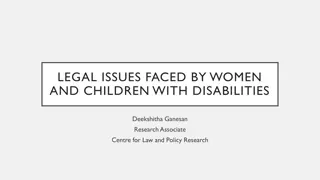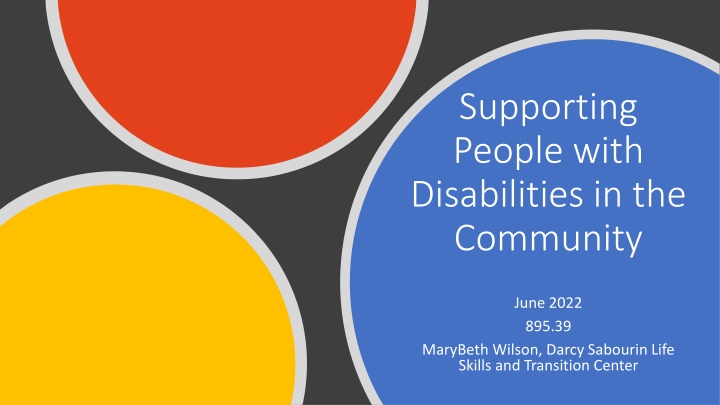
Empowering Individuals with Disabilities in the Community
Explore the diverse needs of individuals with disabilities, addressing when disability can occur, the impacts of labeling, and the importance of recognizing uniqueness. Discover the significance of active support and understanding how different disabilities affect learning and growth.
Download Presentation

Please find below an Image/Link to download the presentation.
The content on the website is provided AS IS for your information and personal use only. It may not be sold, licensed, or shared on other websites without obtaining consent from the author. If you encounter any issues during the download, it is possible that the publisher has removed the file from their server.
You are allowed to download the files provided on this website for personal or commercial use, subject to the condition that they are used lawfully. All files are the property of their respective owners.
The content on the website is provided AS IS for your information and personal use only. It may not be sold, licensed, or shared on other websites without obtaining consent from the author.
E N D
Presentation Transcript
Supporting People with Disabilities in the Community June 2022 895.39 MaryBeth Wilson, Darcy Sabourin Life Skills and Transition Center
Note: The content provided in this summary is not meant to be a substitute for the module. Purpose is to provide the learner with a quick overview of the content of the information provided with in the module as another learning resource. 2
Chapter 1: People with Disabilities Objectives: Explain when disability can occur and what may cause it Recognize that people who share the same disability label are still unique individuals Explain how people with and with disabilities have similar needs Explain how to provide active support and why this is important Explain the positive and negative implication of labels 3
A prenatal disability occurs before birth in the womb A perinatal disability occurs during birth A postnatal disability occurs any time after birth Some disabilities are obvious at birth, others are noticed later. Sometimes a disability is a singe issue. Other disabilities occur as a cluster of conditions (syndromes). Some disabilities are visibly noticeable, others are not. Some are inherited or genetic. Others are environmental. What is important to understand is how the different disabilities impact the person s ability to learn, function and grow and what supports might be needed for the person to reach his or her personal goals and dreams. Causes of Disability 4
Which person is more interesting? Chapter 1 5
Would it surprise you to know that these description are the same person? When we define people by his or her disability or label, it suggests that the person does not have a fully range of physical characteristics or personality traits. We may overlook the many roles that person has ( e.g., son, brother, grandson, employee, neighbor, friend, etc.) The focus is on the deficits rather than strengths and capabilities. Chapter 1 6
People with the same disability label do not always have the same characteristics, personalities and challenges. They so have the same human needs: have attention, love, affections and companionship. We need to be careful about assumptions: someone who does not speak does not want to communicate. Labels were developed for medical description and are used by people in the medical, educational, employment and social setting to determine if the person is eligible to receive services and supports. Chapter 1 7
Negative consequences of a label Lower expectations Low self-esteem Exclusion Negative believed, attitude and discrimination Disrespect Advantages of a label Establishes eligibility for services Services as a means of funding and providing supports Promotes efficient communication amount professionals Focuses research efforts on specific disability conditions Chapter 1 8
Supporting People with Disabilities to Reach Personal Goals self-directed lives, engage in meaningful activities and reach personal goals. As a DSP you are responsible to support people to lead working as part of a team to remove barriers, increase skills. Roles DSP: Chapter 1 Serve as a teacher Serve as a role model Provide active Support Supportive decision making Maintain health and wellness Acting as an advocate Being a change agent 9
Chapter 1 Active Support Core elements: Be engaged do things Actively each day, throughout the day Consistently approaches and routine assist person to be engaged Meaningful ways increase competence (abilities)and opportunity; help people stay connected; enhance self-esteem; focused on needs, preferences and goals of the person 10
Chapter 1 DSP shared in Person-Centered Team Responsibilities Confidentiality scheduled meetings private information implementation of the plan/s need to know basis share in private, respectful manner follow guidelines of policies and HIPAA 11
Chapter 1 Feedback Exercises Refer to the module to complete the feedback exercise for this chapter. 12
Chapter 2: A Brief History of Disability Services Objectives: Describe inhuman treatment people with disabilities experienced in the past Discuss the historical trends that describe treatment of people with developmental disabilities Explain how attitudes toward persons with disabilities have changed over the years Describe the deinstitutionalization mandate List key components of inclusive services and active support Describe how the Arc lawsuit impacted the lives of people with intellectual disabilities in the stat of North Dakota Discuss the concept of self-determination Describe the social model of disability 13
Attitudes Set Policies society needs, and beliefs determined 1800 s 1850 first public education programs started ; gradually changed to people unable to learn lead to large institutions. Concept of disability as an illness or disease. 1890-1950 institutions served to protect society form deviants . People lived in institutions, men and women separated, excluded from communities prohibited marriage and reproduction. 1950 s research began to show negative effects. Chapter 2 1960-1980 parents and local communities began movements to improve conditions. President John F. Kennedy launched panel on Mental Retardation. Lawsuits began to be filled. Self advocacy groups began People First . 1990- Consumer driven services with people having the right to direct their own lives i.e., control their lives, reach goals they have set, take part fully in the world around them 14
Chapter 2 Deinstitutionalization systematic effort to move people from institutions to community. improve institutional conditions and programs return residents to communities develop appropriate community- based alternative 1981 class action lawsuit Arc of North Dakota, landmark decision for people to move to lesser restrictive settings. 15
Results of Arc lawsuit People with developmental disabilities are offered services and support necessary to achieve the unique potential in the community Teaching and supports are provided in community settings People with disabilities are provided the opportunity to give back, as well as receive. Chapter 2 encouraged. decision makers about their own lives. People are supported to develop relationships with family, friends, neighbors, and co-workers. Wherever possible, natural supports are People with disabilities are the primary 16
Chapter 2 Medical vs Social Model of Disability when disability is viewed as an illness = Medical Model some people have differences that affect their ability to function in society = Social Model 17
Social Model Categories of barriers: Environmental environment handicaps the person Economic learning, job skills, accessible workplaces Result unemployment or under employment Cultural encounter negative beliefs, exclusions and discrimination; attitudes stereotypes, prejudices Chapter 2 18
Chapter 2 19
Chapter 2 Feedback Exercises Refer to the module to complete the feedback exercise for this chapter. 20
Chapter 3: A Positive Value Base Objectives: Describe legal rights guaranteed through the Constitution Explain how legislations and court decisions impact the lives of people with disabilities Discuss basic human rights of all people Describe the Developmental Assumption Describe the principle of normalization, social role valorization and social capital Explain the dignity of risk Describe People First Language and identity First Language Describe how define a person based on ly on his or her disability diagnosis or lable may be harmful Indicate three ways to convey respect to people receiving service 21
Chapter 3 Estimated 1 in 5 Americans have a disability. Quality of life for people with disabilities is influences by attitude and values of the people who support then and society in general. This chapter will present key concepts that impact views of people with disabilities . 22
Chapter 3 Human Rights Simply the right to dignity and respect Respect is more than the absence of negative comments and actions Your actions show a great deal about what you think and feel Your words, actions and environment should always promote human dignity Confidentiality being sensitive to and not sharing without need to know Using Person First Language or Identity First Language based on the person s preference 23
When writing about or discussing the people whom you support: Do not mention the person s disability unless it is needed Avoid stories about chronic illness or severe disabilities Do not describe people with disabilities a superhuman Do not sensationalize a disability Chapter 3 Avoid emotional words Avoid rewording handicapable, mentally different FOCUS on abilities instead of limitations FOCUS on issues that affect quality of life SHOW people with disabilities as active participants in society 24
Legal Rights Constitutional Rights Equal protections government treats every citizen the same Due Process every person right to treated with fundamental fairness Statutory Rights Public Law 94-142 Equal education for all Handicapped Children Rehabilitation Act 1973, 1992, 1998 live independently, self determined lives, make choices, contribute to society, pursue meaning full careers, enjoy full inclusion in mainstream society Chapter 3 Americans with Disabilities Act ( ADA) 1990 *public accommodations, employment, transportation, state/local gov t services, telecommunications Court Decisions Olmstead Decision 1999 Community care options for people with disabilities 25
Normalization, Social Valorization, and Social Capital ..using methods and settings which are valued and familiar, to offer each person life conditions which are at least as good as those of the average citizen, and as much as possible to enhance and support each person s behavior, status, and reputation Includes typical patterns and conditions of everyday life Social and Community Integration live, sense of belonging, cared about, using community resources, social activities Social Capital network, connections with neighbors, friends, co-workers ties and trust we have with other people: family, friends, neighbors, social groups and coworkers Age-Appropriate Chapter 3 Social integration easier when people look and act in ways that are acceptable. Minor details often make the difference: avoid stereotypes, noticeable differences (spiderman lunch box, child's menu, using crayons, piggy bank, someone speaking for) Goal is to help create and support roles that are valued by society As a support person your roles is to assist people to speak up , take a turn or participate in the activity 26
Chapter 3 Developmental Assumption Dignity of Risk 27
Chapter 3 Feedback Exercises Refer to the module to complete the feedback exercise for this chapter. 28
Chapter 4: Effective Person-Centered Services Objectives: Describe the purpose of policy and procedures Explain CQL s Personal Outcome Measures (POMs) Explain the role of Protection and Advocacy Describe the Title XIX survey process and purpose Explain DSP roles related to accreditation and surveys of agency services Explain the purpose and major function of DD Program Management services The goal of monitoring services is to ensure that people receive the best possible quality of life. Agencies that provide services are accountable to monitoring bodies. 29
Chapter 4 Policy is a statement. Procedure describe to policies are carried out. Review and updated based on new technology, regulations, service options, new ways to provide person-centered service. All ND agencies must be accredited by The Council on Quality and Leadership (CQL) Personal Outcome Measures are a tool used to learn about and support individual choice and preferences. See module for a listing of 21 POMs. Monitor services through personal interviews, visits to agency, talking with staff members and other connected with the agency. 30
Title XIX Intermediate Care Facilities for People with and Intellectual or Developmental Disability (ICF/IDD) are funded through Title XIX of the Social Security Act or Medicaid. ICF/IDD designed to provide active treatment services to persons. Surveyors from the State Department of Health evaluate if the person s needs are being met by reviewing person-centered plans. Chapter 4 Home and Community Based Waivered Services (HCBS) Guideline indicate people receiving services and supports must have full access to benefits of community living and receive supports in the most integrated settings. Protection and Advocacy Each state and territory has a system to advance human and legal rights of people with disabilities. Primary responsibility in ND is to address complaints of abuse and neglect of people with developmental disabilities and mental illness. 31
Developmental Disabilities Management Service DD Program Management Services located in the 8 Human Services Centers. Single point of entry into the DD service deliver system. Program Manager (DDPM) helps connect the person to service. Assessment Authorization of Payment Chapter 4 Plan development Monitoring and quality assurance Advocacy & Support for people & their families 32
Chapter 4 Feedback Exercises Refer to the module to complete the feedback exercise for this chapter. 33
Chapter 5: Development and Intellectual Disabilities Objectives: Explain Developmental Disabilities and Intellectual Disabilities Recognize important considerations for supporting people who have a variety of sensory disabilities Describe general support for people with disabilities Explain the role of the person-centered planning process Understand how the learning priorities are determined 34
Chapter 5 Developmental Disabilities -a group of conditions that are due to impairment in learning, physical, language or behavior areas -characteristics that impact causing a severe, chronic disability -umbrella term that includes Intellectual Disabilities caused by a mental or physical impairment or combination occurs before age 22 is likely to continue forever results in functional limitations in 3 or more major life activates reflects the person s need for a combination or sequence of special interdisciplinary or generic care, treatment, or other services which are lifelong or extended duration 35
DD causes Genetics- chromosomal abnormalities Parental health and behaviors during pregnancy smoking, drink, drugs Birth complications Infections the mother has during pregnancy Infections the baby has very early in life Exposure to high levels of environmental toxins Chapter 5 36
Intellectual Disability impairments of general mental abilities that impact adaptive functioning in three areas 1) conceptual domains includes skills in language, reading, writing, math, reasoning, knowledge and memory 2) Social domain refers to empathy, social judgement, interpersonal communication, ability to make and retain friendships, and similar concepts 3) practical domain of self-managements in areas such as personal care, job responsibilities, money management, recreation and organization tasks Chapter 5 Occurs before age 22, IQ score around 70 or 75 37
IDD Causes Number of causes of ID are related to various risk factors before the person is born, at birth, and after birth biomedical social behavioral educational Chapter 5 38
Chapter 5 General Supports When supporting people with intellectual or developmental disabilities, keep the following tips in mind: Move to an area that is quiet and free from distractions if possible. Be prepared to repeat what you say, orally, in writing, or using pictures. Place yourself at eye level with the person, establish eye contact, and face the person as you speak so they can watch your facial expressions. Use gestures appropriate to the context. Use words that are easy to understand (for example, ask the person if he would like a can of pop or a coke, instead of using the word "beverage"). Emphasize key words. Give directions one step at a time and check for understanding before going on to the next step. 39
Chapter 5 Check for understanding by having the person state the information back to you or ask questions to check for understanding. Do not pretend to understand. Ask the person to repeat the message or ask questions if you do not understand. You can also ask another person for assistance if needed Do not attempt to help by communicating for the person. Let the person speak for himself or herself. Look for an alternative method if you are not successful communicating with the person. Ask if they have a communication book or if they use sign. Be prepared to wait at least 15-20 seconds to give the person time to process what was said and then respond to it. It may be even longer for some people. It is important to get to know each person and what works for them. Always use age-appropriate communication skills. Consider your choice of words and your tone of voice. 40
Chapter 5 Be patient think how frustrating it might be to be limited to the words and phrases selected for you and put into a communication book or a voice output system. Use natural supports when possible. This will help the person you support to be part of their community, and to rely less on staff. Natural supports include coworkers, neighbors, friends, family, store workers, etc. Use natural opportunities throughout each day to engage the person you support. When possible, teach in naturally occurring situations to promote the person s ability to generalize learned skills to a variety of settings and with a variety of people. Skills that are taught in isolated training situations are usually not generalized to other situations. 41
Chapter 5 Person Centered Planning (PCP) foundational for all supports provided by disability support agencies person with disabilities has a key role in planning process meet at least yearly to review services received by person plan has goals, objectives, services and supports to help person get what they desire and live the life they want other members may be family, guardian, advocate, DSP, speech therapist, OT, PT, psychologist, social worker, teacher, friend Assessments to determine what the person enjoys, wished to do, can already do, how best to support the person to achieve their dreams and goals 42
Chapter 5 Personal Goals What does the person want to learn? What does the person need to stay healthy and safe? What would help the person be more actively engaged in meaningful activities? What will the person have many opportunities to practice? What is the person likely to learn quickly? What will improve opportunities for community participation and relationships? 43
Learning longer a combination to adaptions and supports are used i.e., learning job duties some skills are not prioritized because the person will struggle for a long time, support is designed or adaption in put in place i.e., balancing a checking account Partial participation used teach part of the task, everyone is capable of completing some part of any activity some skill are more difficult and take Chapter 5 44
Strategies that could be used to increase participation include: Adaptive/prosthetic aids - For example, a person could use a ramp to roll the bowling ball down the lane if they cannot lift, carry, and roll the ball on their own. Adapting activity materials - An extra-large bingo card could be used for people who have difficulty seeing the smaller squares or a specific square could be isolated to show the person where to place the dabber. Chapter 5 Another example of adapted materials is color-coding to highlight what the person needs to do. Adapting rules - In basketball, a two-handed dribble could be allowed, or players could be allowed to carry the ball if they are unable to dribble with one hand. Changing the skill sequence - A person could change into their swimming suit at home and wear sweats over the top to go to the pool instead of changing in the locker room at the pool if dressing is difficult. 45
Chapter Feedback Exercises Refer to the module to complete the feedback exercise for this chapter. 46



